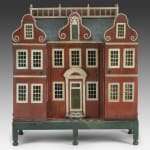'Mr. Joy's Surprise' - Queen Anne Child’s Wardrobe in the form of a House
65 ¼ x 57 ½ x 26 in
Further images
Provenance
1950s Eden Minns, a designer for Gordon Russell;Sold Christie’s, London, c. 1966 - 25 November 1965?;
Private Collection;
Sold Phillips, London, 1985;
Acquired from Alistair Sampson, London;
Private Collection, USA.
Literature
Vivien Green, 'English Dolls' Houses of the Eighteenth and Nineteenth Centuries', London: B.T. Batsford Ltd, 1955, p. 99-100, no. 58;David Coombs, ‘The Connoisseur’, April 1966 – ‘Finally a charming oddity: a child's wardrobe in the form of a doll's house... with three Dutch gables and slightly projecting wings; width 58 in., signed '1709 Edmund Joy', £230 (Christie's).’ p. 263;
Jane Toller, 'English Country Furniture’, (South Brunswick, A. S. Barnes), 1973 p. 101-102;
Edward Gelles, 'Nursery furniture : antique children's miniature and doll's house furniture', (London, Constable) 1982, p. 94;
Constance Eileen King, ‘The collector's history of dolls' houses, doll's house dolls, and miniatures’ (New York : St. Martin's Press), 1983, p. 190-191;
The Magazine Antiques, January 1986, p.164 (advertisement);
Peter Johnson, 'The Phillips Guide to Tomorrow's Antiques', Weidenfeld and Nicolson, 1987, ill. p. 101 (states that the house sold at Phillips in 1985 for £11,000);
Huon Mallalieu, 'The Illustrated history of antiques: the essential reference for all antique lovers and collectors' (Philadelphia, Pa.: Running Press), 1991, ill. p. 563;
Victoria & Albert Museum; object detail and gallery label (2004) for no. W.36-1930 describes the 1709 wardrobe as 'Mr. Joy's Surprise', https://collections.vam.ac.uk/item/O91201/wardrobe-joy-edmund/
Constructed from elm, pine and glass, The steps and entrance area of the house painted with a black and white chequerboard pattern. The central door opening to reveal a hanging space with pegs; the left-hand door opening to four half-depth shelves lined with paper decorated with a brickwork pattern; the right-hand door concealing an arrangement of four long and four short drawers, hand-painted with red dots, green lines and floral designs including tulips; each lined with red and cream chequerboard-pattern paper and with cast brass drop handles with backplates cast as roses. Each door with the original lock and key escutcheon. The back boldly signed and dated ‘1709 Edmund Joy’ and with later pencil sketches of metalware. The rear right-hand panel signed faintly ‘Edmund Joy 1709’. On a later painted pine stand with turned feet. Some repairs and replacements. The galleried roof with a broad central dowel, probably to support a cupola.
The only known comparable wardrobe, also signed ‘Edmund Joy’ and dated three years later than this one is in the collection of the Victoria & Albert Museum, London (no. W.36-1930). Such pieces of furniture would have been made for the children of a wealthy family.
During the early part of the 18th century, such ‘baby’ houses and dolls’ houses were constructed according to designs by architects, in contrast to the more generic models that emerged later in the century. At that time, they were not intended as playthings for children, as evidenced by their superior craftsmanship and the presence of locks on the doors; instead, they served as objects of fascination and curiosity for adults. As such, this wardrobe can be considered a particularly rare piece as it was made for storing children’s clothes rather than as a plaything or a piece for adult interest.
On the use of wardrobes in this period, the V&A states ‘The word ‘wardrobe’ in the 1710s referred not to a piece of furniture, but to a room or building where clothes were kept locked away. Clothes and linen were usually folded and stored flat in chests or ‘clothes presses’. Clothes, when hung at all, were hooked onto pegs’.
The style of the hipped roof and curved, scrolling gables points to 17th century Dutch domestic architecture which influenced houses in England, particularly in London and the south east. Kew Palace, known as the ‘Dutch House’ is a prominent example of this style, which was built in 1631.
Since two wardrobes are extant, dated three years apart, it seems likely Joy was the maker of this cabinet, rather than the owner. The V&A states ‘This is probably the maker, though nothing is known of this proud craftsman who so confidently signed his work.’
A man named Edmund Joy is buried in a central, prominent position in Barton Turf church, Norfolk. He died a bachelor in 1744 aged 63, and the location and dates indicate he could be the maker of these pieces, but no further evidence has been found to confirm this.








